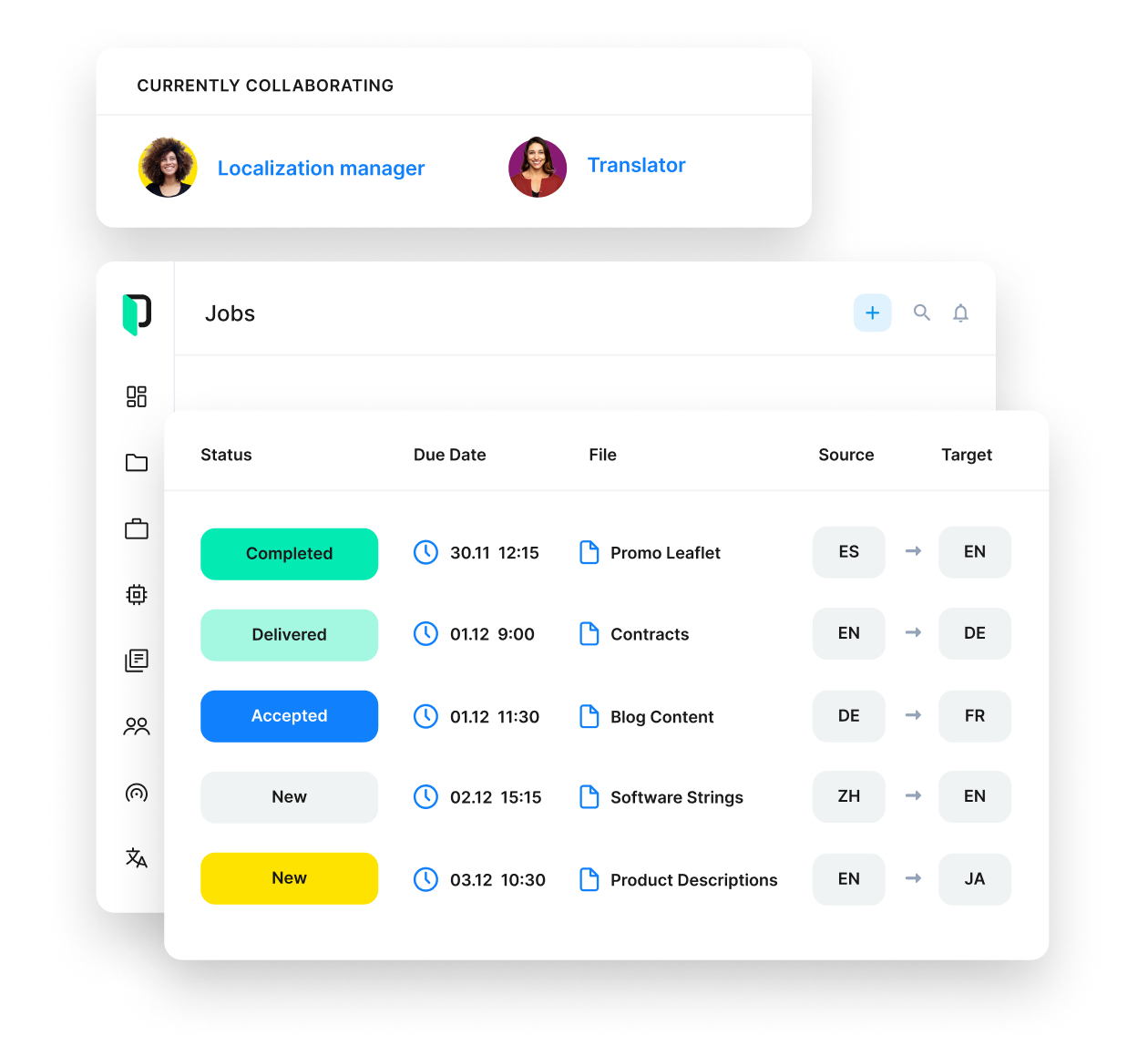Global business
Global Content Strategy: Making Global Content Work in Local Markets

In an ever-evolving global market, 65% of consumers prefer content in their own language. To connect effectively with as many as possible, growing businesses leverage global content marketing. Through customized content for the cultures and languages of audiences in diverse target markets, they’re able to expand their reach, drive engagement, and boost revenue across borders.
Building a comprehensive global content strategy is a detailed process that requires time and careful evaluation. However, by breaking it down into manageable stages from the start, you can effectively create, manage, and distribute multilingual content that truly resonates with local audiences. This guide will help you build your own strategy step by step.
What is global content marketing?
Global content marketing is the strategic approach of creating, managing, and distributing relevant and valuable content to a worldwide audience. It aims to attract, engage, and retain customers across different cultures and languages, ultimately driving international business growth.
More specifically, the core goal of global content marketing is to establish a strong global brand presence while acknowledging and adapting to the unique preferences and needs of people in diverse target markets. This involves crafting content that transcends language barriers, cultural differences, and local sensitivities to effectively resonate with audiences in each market.
By leveraging various channels and platforms, such as social media, websites, blogs, and multimedia content, global content marketing enables businesses to foster meaningful connections with consumers on a global scale, driving brand awareness, loyalty, and business growth.
The difference between global and multilingual content marketing
Global content marketing aims to create content that can be used across various markets and languages with as minimal modification as possible. In contrast, multilingual content marketing is focused on tailoring content to specific language-speaking segments within different markets.
Devising a global content strategy in 5 key steps
As more businesses than ever connect with international audiences, a well-crafted global content strategy becomes an essential source of competitive advantage and success in each target market.
Let’s walk through the 5 essential stages of an effective global content marketing strategy: From strategic planning and market research to implementation and measuring performance—each step plays a crucial role in ensuring your content resonates with audiences worldwide and drives business growth.
Defining clear global content marketing goals
Before you start developing your global content strategy, it’s crucial to establish clear goals that align with your business roadmap. This will shape the direction of your strategy. Be it increasing brand visibility, improving customer engagement, or boosting conversion rates from leads to customers—by clearly defining what you aim to achieve, you can effectively plan and execute your content marketing initiatives.
Consultation
The most important step at the beginning is consulting with the people who will implement your global content strategy. Be it marketing managers, designers, copywriters, content creators, or translators, you need to understand their goals and how they work. Additionally, they need to understand how the global content strategy will benefit them. Your teams will feel much more motivated to follow your strategy if they’re involved in its creation and goal setting.
Governance
Consulting with stakeholders will also help you decide how best to govern your global content. Will it be created, published, and maintained centrally in a content management system (CMS), or will you have a decentralized model with different business units or even local teams in each target market taking care of their own content? Another option would be to employ a hybrid model combining both approaches, but it all depends on your goals and possibilities.
Goal setting
Once you’re ready to start documenting your global content strategy, it’s crucial to keep a clear distinction between goals, key performance indicators (KPIs), and metrics to ensure effective planning and measurement of your strategy’s success:
- Goals set the direction for your overall global content strategy.
- KPIs act as measurable indicators of progress towards achieving those goals.
- Metrics offer insights at a granular level to facilitate the assessment of content performance.
| Common goals, KPIs, and metrics in global content marketing | ||
| Goal (high-level) | KPI (measurable) | Metrics (specific) |
| Establish industry authority in the DACH region. | Increase website traffic by 20% in Germany, Austria, and Switzerland. | Total page views, unique visitors, referral sources, bounce rate |
| Foster brand loyalty in the US market. | Boost engagement in social media channels in the US by 15%. | Time spent on page, social media interactions (likes, shares, comments), click-through rate (CTR) on social posts |
| Expand the customer base in Japan. | Achieve a 10% conversion rate on Japanese landing pages. | Conversion rate per landing page, total form submissions, download numbers for gated content |
These tailored KPIs and metrics reflect specific markets, ensuring that your global content strategy aligns with regional objectives and audience preferences.
Regularly tracking and analyzing these indicators will provide valuable insights to optimize content performance and achieve successful outcomes in each target market.
Conducting market research and competitor analysis
At this stage, begin delving deep into your target markets and the activities of your competitors in those regions to gather the necessary insights for informing your global content strategy.
Audience needs and wants
Put your audience at the forefront of your market research efforts. Create detailed buyer personas for each target market to highlight their unique preferences, interests, and pain points. For example, fashion brands expanding overseas need a strong understanding of fashion trends, style preferences, and purchasing behaviors of customers in each target market.
Also, consider how your audience consumes content—whether they prefer video, written articles, or social media posts—and align your content goals to address their specific needs. This can help you deliver content that resonates with your audience, fostering stronger connections and loyalty.
Content inventory and audit
Conducting a thorough content inventory and audit of your own assets is equally important. Compile a comprehensive list of existing pieces across all languages and platforms. For example, an ecommerce company looking to expand globally should review its product descriptions, blog posts, and email marketing campaigns in each target market and evaluate the relevance, accuracy, and performance of each content item.
This audit process will help you understand your content’s strengths and weaknesses, identify high-performing content to repurposed for international markets, and recognize any content gaps that need to be addressed. By leveraging your existing content effectively, you can optimize your global content strategy and ensure a cohesive brand message across diverse markets.
Competitors and gaps
To gain a competitive edge, it’s best to analyze your competitors’ content. Identify gaps in your competitors’ content offerings compared to your own and leverage these insights to develop content that fills those voids, ultimately positioning your brand as a valuable resource in each target market.
For example, a travel agency aiming to increase organic website traffic through international SEO should analyze how competitors optimize their content for specific keywords in each target language or country. This analysis will provide valuable insights to refine your own content approach, optimize for local search intent, and enhance organic traffic growth across diverse international markets.
Mapping out your global content
By now, you will have a solid understanding of your existing content landscape. This includes greater clarity on your target audience and their wants and needs. You will also know the types of content you need to create. From here, you can start honing your strategy and working out how to impliment it.
User journeys
User journeys show how your target audience will interact with your content. Identify the different paths users may take, from initial discovery to conversion. Understand their preferences, pain points, and expectations at each stage to tailor your content effectively.
Content mapping
Next, you can take user journeys a step further by mapping out your content. Consider what types and formats of content you’d like to provide for readers at each point of the journey and where you will publish it.
As you work on your content map, make sure each piece advances your content goals. Know what job each piece of content needs to do—and think about which content pieces will be localized. Planning this before the actual creation simplifies the process by optimizing your content for localization.
Content planning
Finally, you’ll need to create a comprehensive plan for executing your global content strategy. Outline timelines, assign responsibilities, and set milestones. You can use a content strategy document to refine and update with your team’s progress, ensuring everyone involved is aligned with the strategy’s objectives.
Creating, publishing, and distributing global content
Once you’ve started your global content strategy, you can start breaking it down it manageable steps for the team that will be implementing it.
Clearly defining workflows and processes will reduce the likelihood of errors and delays, ensuring smooth delivery of content.
You can begin with a process for idea generation, collation, and evaluation, and then move on to content creation, translation, localization, editing, proofreading, publishing, and distribution.
Content creation
Content creation is the stage where content writers, copywriters, or local marketing specialists transform content briefs into high-quality, engaging content formats. This can be a costly endeavor, so prioritizing content assets for each target market based on their return on investment is advisable. While some content formats can be created from scratch, others may be translated using machine translation (MT) tools or fully localized with the help of professional linguists.
Translation and localization
When developing your global content strategy, think about how you will adapt content to meet the cultural, linguistic, and other requirements of each target market. This process is known as content localization and goes far beyond translation. By having it ingrained in your strategy from day one, you can ensure the highest possible relevance and quality of your content across various languages.
Tip: If you optimize blog posts for search engines, you need to ensure that you know the right keywords in each target language or country. In the UK, for example, “chips” refers to thick fried potato pieces, while in the US, “chips” are thin fried potato slices (potato chips)—so using the appropriate variants will adapt your content accurately.
To optimize localization costs, you can rely on MT to quickly translate less critical content, but for important or sensitive material that requires accuracy and creativity, human translation is still your best bet. Let’s take a look at 3 key content types and find the best translation method for each of them.
Raw machine translation
Suitable for low-impact, low-visibility, and unambiguous content:
- Internal documentation
- Website footers
- Social media posts (for sentiment analysis)
- Repetitive technical content (not requiring 100% accuracy)
- User-generated content like product reviews
- Chat or email support messages
Post-edited machine translation
For more sensitive content, but not critical enough for full human translation:
- Product titles
- Product descriptions
- Knowledge bases
- Frequently asked questions (FAQs)
- Back-end SEO meta information (alt texts and captions)
Human translation/transcreation
For high-traffic, durable assets requiring transcreation and sensitive or confidential content:
- Homepages or landing pages,
- Blog posts
- Customer-facing newsletters
- Press releases
- Paid advertising
- SEO content
- Legal or contractual documentation
On-demand webinar
How marketers can effectively leverage machine translation
Learn from our expert panel how to keep up with the ever-growing demand for translated content and to scale to new markets without compromising your brand.
Global brand guidelines
Establish comprehensive brand guidelines that provide content creators and translators with clear direction on maintaining global brand consistency. Cover aspects such as voice and tone, imagery style, animation guidelines, iconography, etc. Ensuring alignment with your brand’s identity and goals across all content helps reinforce the brand’s presence and enhances recognition and trust across markets.
Distribution channels
Clearly outline which content formats are best suited for which channels and platforms for distribution in different target markets. This is a key aspect of marketing localization and will ensure that your content is optimized for each channel’s unique characteristics and audience preferences, maximizing its reach and impact.
Tip: In the US market, for example, you can reach a broad audience by sharing visually engaging content such as infographics and videos on channels like Facebook, Instagram, and Twitter. In contrast, in the Chinese market, you can focus on more long-form articles, which align with audience preferences, on platforms like WeChat and Weibo.
Measuring effectiveness and optimizing your global content strategy
You will want to constantly evolve and improve your content. That’s why it’s vital to work out how you will measure and optimize its performance—and then include that in your strategy.
To ensure you measure the right things for the right reasons, always be guided by your content goals. This will help you set the most relevant and useful KPIs while keeping you focused on achieving your goals.
- Empower data-driven decision-making by setting up conversion goals and track relevant metrics, such as pageviews, time on page, bounce rate, and conversion rates using Google Analytics to for data-driven decisions.
- Track engagement metrics, including likes, shares, comments, and click-through rates using social media analytics tools, such as Hootsuite, and monitor audience sentiment and interactions to tailor your content strategy based on insights.
- Implement A/B testing for key elements of your content, such as headlines, CTAs, and visuals, by leveraging the A/B testing capability of your CMS, to continuously test variations and identify the most effective elements for content refinement.
- Share market and language-specific data with all teams involved. While content teams should have access to localization data, localization teams need to understand key marketing data. Shared insights can help inform content adaptation for each target market.
- Collect customer feedback through feedback forms on your website or by conducting surveys to gain qualitative insights into the effectiveness of your content and quickly address any issues to enhance the content experience.
A powerful global content strategy calls for strong technology
Providing global content for a strong customer experience across markets is a bold endeavor, but one that can be made easier with a clear strategy and robust technology. By connecting your CMS and preferred marketing automation tools with a cloud-based translation management system (TMS), you can seamlessly integrate localization into your global content strategy.
More specifically, you need a translation management system that will:
- Centralize your content localization efforts to increase productivity, quality, and revenue.
- Foster real-time collaboration on a single platform to ensure a seamless, accurate, and on-time translation and localization workflow for both in-house and external stakeholders.
- Allow you to submit content for translation in familiar file formats that you’ve been using in your global content marketing endeavors: IDML, PSD, SVG, HTML, etc.
- Offer out-of-the-box integrations with your content management system (e.g., a WordPress translation plugin for your multilingual WordPress site) or marketing automation tools such as HubSpot and Adobe Experience Manager—or lets you build a custom integration via an API.
- Combine well-established translation technology such as translation memory and term bases with AI-powered machine translation capabilities.
- Provide a holistic approach to data security and encryption through an information security management system.

Phrase TMS
The enterprise-ready translation management system
Work with the leading TMS to automate translation workflows with cost control and quality checks.





